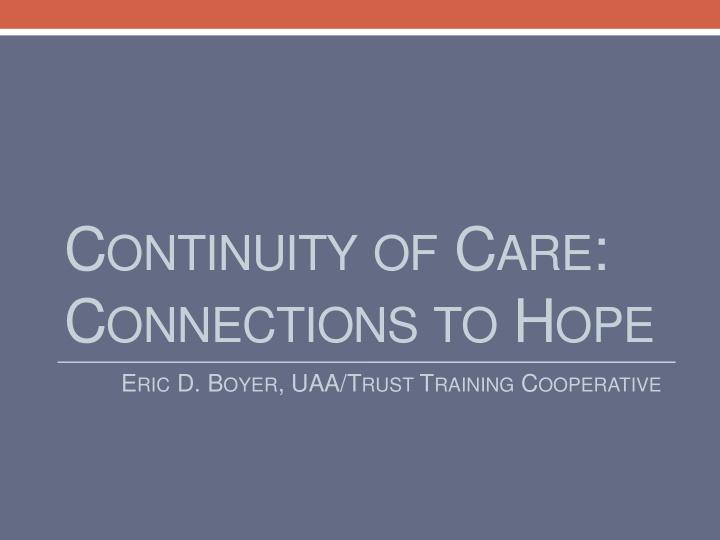



C ONTINUITY OF C ARE : C ONNECTIONS TO H OPE E RIC D. B OYER , UAA/T RUST T RAINING C OOPERATIVE
Disclosure to Audience______________________________________ No one involved in the planning or presentation of this activity has any relevant financial relationships with a commercial interest to disclose The following are North Star Behavioral Health’s Content Controllers: Eric D. Boyer - Presenter Dr. Andy Mayo, CEO Dr. Ruth Dukoff, System Medical Director Lori Hoffman, QIRM Director Denise Gleason, CME Coordinator Evelyn Alsup, Education Resource Manager Medical Staff: Dr. Phillip Neuberger Dr. David Hjellen Dr. Judith Bautista Dr. Jill Abram Education Committee: Sabrina Ben, HRD Carla MacGregor, DRTC Administrator Ron Meier, PRTC Clinical Director Melanie Nelson, DOSS Brandy Proctor, DON Sarah Skeel, PRTC Administrator Business Development Department: Elke Villegas, Director of Business Development Becky Bitzer, Clinical Community Liaison Sarah Twaddle, Clinical Community Liaison Wayne Jackson, Clinical Community Liaison
T HE P RINCIPLES OF CONTINUITY OF CARE • Why is Continuity of Care important in regards to suicide? • Settings in which at risk youth are identified, and the trauma of transitions. • Reducing the risks of suicidality and the ongoing role of follow- up As long as a person is living, there is an opportunity to prevent suicide.
C ONTINUITY OF C ARE I S MAINTAINED WHEN ONE CARE PROVIDER LINKS TO ANOTHER CARE PROVIDER , THE TRANSITION OF CARE IS SMOOTH AND UNINTERRUPTED FOR THE PATIENT , AND THE ESSENTIAL CLINICAL INFORMATION IS PROVIDED .
W HY IS C ONTINUITY OF CARE IMPORTANT IN OUR A LASKAN COMMUNITIES ?
A DOLESCENCE /Y OUNG A DULT
C HALLENGES OF L IFE T RANSITIONS : • Adolescence to adulthood/work/school • Military veterans back to civilian life • LGB youth • Youth in detention Draper, 2014
“T RANSITION T RAUMA ” W HEN CHANGE FEELS OVERWHELMING • Thwarts belongingness and worth (humiliation, real or perceived community rejection, unemployment) • Enhances feelings of interpersonal loss, disconnection (loss of loved ones, community, etc.) • Is so pervasive that it resists establishing daily routines over an extended period of time (eating, sleeping, working, socializing, recreation, etc.)
WHAT REDUCES RISKS FOR PERSONS EXPERIENCING “TRANSITION TRAUMA”: CONTINUITY OF CARE AND FOLLOW-UP S TRATEGIES OR SERVICES TO ENHANCE LINKAGES SAMHSA
F OLLOW U P M ETHODS THAT D ECREASE S UICIDALITY Location of Study Telephone only 54% reduction in suicidal ideation Telephone + limited 6x fewer suicides contacts Caring Letters Significant reduction in suicides Caring Postcards Reduced attempts 50% Text messages/E-mail Attempts reduced
C OMPONENTS OF F OLLOW - UP ? • Best case scenario is 1-7 days-warm handoff optimal. • Goal setting: When does it end? • Good contacts. • Ongoing assessment. • Safety planning.
6 STEPS OF S AFETY P LANNING 1. Stressors and triggers 2. Personal warning signs 3. Personal coping tools 4. List of contacts who will be my support network 5. Professionals and agencies to contact 6. Making the environment safe Quinnett, 2010
13 W HO CAN DO THE FOLLOW - UP ? • Peers • Professionals • Trained volunteers • Crisis Centers • Lifeline Crisis Centers
14 Lifeline Crisis Centers and Follow-up Experience with follow-up: Highly trained staff/volunteers Community involvement: Use of volunteers Community-wide access: Free access to all, no stigma, no care barriers if have phone Community of providers: Refer to other services Community outreach: public education, training
15 H OW THE LIFELINE WORKS …. • Callers dial 1-877-272-8270 or 1-800-suicide • Callers are connected to closest center • “Press 1” for veterans, military • Crisis workers listen, assess, and link/refer callers to services, as needed • Extensive back-up system ensures all calls are answered Draper, 2014
A DDITIONAL THINGS WE ARE DOING IN AK • DBH prevention and early intervention GLS funding is being used for Early Identification, Referral and Follow-up (EIRF) • Supporting agencies and regions to track their high risk individuals • Supportive MOAs to help facilitate this process • Technical support from UAA
A LASKA C ARELINE 877-266-HELP (4357) 24-HOURS A DAY, 7 DAYS A WEEK Text ' 4help ' to 839863 Text line available Tues-Sat, from 3PM -11PM www.carelinealaska.com Calls are caring & confidential .
N ORTH S TAR BHS – CME A CTIVITY C OURSE E VALUATION F ORM Date: 08/19/2014 Starting Time: 12:00pm Location: North Star Behavioral Health - Anchorage Topic: Continuity of Care: Connections to Hope Presenter(s): Eric D. Boyer – Training Coordinator Trust Training Cooperative/UAA’s Center for Human Development At the conclusion of this activity, participants should be able to: Not at All Slightly Moderately Mostly Completely Recognize the traumatic transitional periods of life that teens and young adults experience, and identify how to play a role in reducing the risks of suicidality in them during these times. Utilize the 6 steps of a safety plan for supporting someone with suicidal ideation and past attempts. Implement a follow-up plan and involve other professionals, family members and community members in that support Was the presentation commercially biased in any manner? Yes [] No [] Based on this activity, what will you do differently in your practice? _______________________________________ Topics of Interest for future Seminars: _______________________________________________________________ Printed Name of CME participant: _____________________________________ Physician Yes [ ] No [ ] Signature of CME participant: _______________________________________________________________ Agency/Organization: _____________________________________________________________________ Email: _________________________________________________________________________________ Are you on our email distribution list? Yes [ ] No [ ] If not – do you wish to be added for future CME events? Yes [ ] No [ ]
More recommend